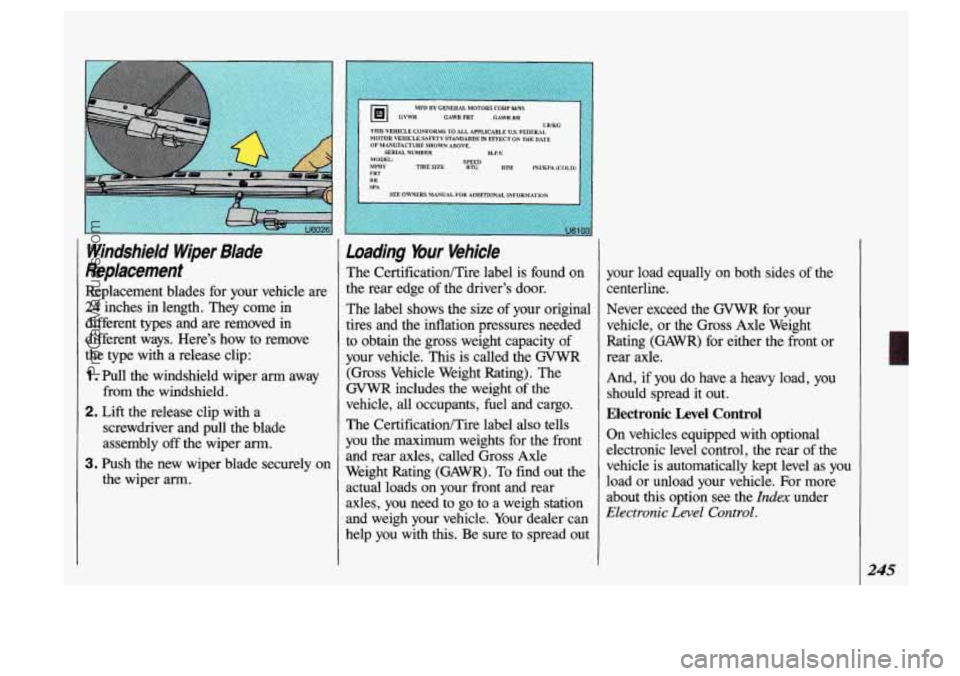Page 222 of 323
Service & Appearance Care
220
* If you get gasoline on you and
- then something ignites it, yor
could be badly burned. Gasoline
can spray out on you
if you open
the fuel filler cap too quickly. This
spray can happen if your
tank is
nearly full, and is more likely in
hot weather. Open the fuel filler
noise
to stop. Then unscrew the
cap all the way.
ap slowly and wait
for any "hiss'
type. Your dealer can
If you get
the
your fuel tank
not fit or have
I
Checking Things Under
the
Hood
The following sections tell you how to
check fluids, lubricants
and important
parts underhood.
When
you put the cap back on, turn it to
the right until you hear a clicking noise.
ProCarManuals.com
Page 247 of 323

Windshield Wiper Blade
Replacement
Replacement blades for your vehicle are
24 inches in length. They come in
different
types and are removed in
different ways. Here's how to remove
the type with a release clip:
1. Pull the windshield wiper arm away
from the windshield.
2. Lift the release clip with a
screwdriver and pull the blade
assembly
off the wiper arm.
the wiper arm.
3. Push the new wiper blade securely on
CAWRFRT GAWRRR
THIS MH1CX.E CONNJRMS TU ALL APPLICABLE US FEDERAL
OF MANUFACWRE SHOWN ABOVE. MOTOR YWICLE SAFETY SPANDARDS lN EFFECT ON TAe DAn
SERIAL MlMBBR
TIRESIZE '%ED RIM PSYKPA(C0LD)
Loading Mur Vehicle
The CertificatiodTire label is found on
the rear edge of the driver's door.
The label shows the size
of your original
tires and the inflation pressures needed
to obtain the gross weight capacity of
your vehicle. This is called the
GVWR
(Gross Vehicle Weight Rating). The
GVWR includes the weight of the
vehicle,
all occupants, fuel and cargo.
The CertificatiodTire label also tells
you the maximum weights for the front
and rear axles, called Gross Axle
Weight Rating (GAWR). To find out the
actual loads on your front and rear
axles, you need to go to a weigh station
and weigh your vehicle. Your dealer can
help you with this. Be sure to spread out your load equally on both sides
of the
centerline.
Never exceed the
GVWR for your
vehicle, or the Gross Axle Weight
Rating (GAWR) for either the &ont or
rear axle.
And, if you do have a heavy load, you
should spread
it out.
Electronic Level Control
On vehicles equipped with optional
electronic level control, the rear of the
vehicle
is automatically kept level as you
load or unload your vehicle. For more
about
this option see the Index under
Electronic Level Control.
L
245
ProCarManuals.com
Page 250 of 323

Service & Appearance Care
248
Inflation-Tire Pressure
The CertificatiodTire label which is on
the rear edge of the driver’s door shows
the correct inflation pressures for your
tires, when they’re cold. “Cold’’ means
your vehicle has been sitting for at least
three hours or driven no more than a
mile. Don’t
let anyone tell you that
underinflation
or overinflation is
all right. It’s not. If your tires don’t
have enough air (underinflation),
you can get:
Too much flexin1
Too much heat
Tire overloadine
Bad wear
Bad handling
Bad fuel economy.
If your tires have too much air
(overinflation), you can get:
Unusual wear
Bad handling
Rough ride
Needless damage from road
I
When to Check:
Check your tires once a month or more.
Don’t forget your compact spare tire. It
should be at
60 psi (420 kPa).
How to Check:
Use a good quality pocket-type gage to
check tire pressure. Simply looking at
the tires will not tell you the pressure,
especially if you have radial tires-
which may look properly inflated even if
they’re underinflated.
If your tires have valve caps, be sure to
put them back on. They help prevent
leaks by keeping out dirt and moisture.
ProCarManuals.com